Tuesday, October 16, 2012
Sunday, September 23, 2012
Pectoral Sandpiper (Calidris melanotos)
This juvenile Pectoral Sandpiper (Calidris melanotos) has been present from last Sunday (16.09.) to at least Thursday (22.09.) at Lagoa dos Salgados (Silves), where I photographed it when it was feeding close to the watchpoint together with Dunlins, Sanderlings, Curlew Sandpipers and Little Stints. The bird was found by my friend and colleague João Ministro when he visited the lagoon with a group of Portuguese birdwatchers.
Sabine's Gulls where among the highlights of the 3 Pelagic trips I organized this past week, 6 birds on Tuesday, 18th and at least 4 birds on Saturday, 22nd (off Fuseta). Also 5 species of Shearwaters, two species of Storm-Petrels and 3 species of Skuas have been seen during the trips, among others. I add a video of a Great Shearwater I made on Tuesday here: Great Shearwater off Fuseta, September 18th
Today it rained and so the summer draught will soon disappear hopefully. Migration is strong underway, on the cape of Sagres as well as everywhere along the coast. Black-winged Kite, Osprey and Booted Eagle were around in Ludo (Faro) yesterday.
Friday, August 31, 2012
Summer
 |
| Spanish Imperial Eagle (Aquila adalberti) immature, 2nd cy, near Mértola. 30th of May 2012. Foto: Gaby Dienst. |
On a trip to the Cape of Sagres and St. Vincent earlier this week (28-08), we saw a first Whinchat and Short-toed Larks and Tawny Pipits could be found in the open and still dried out countryside. Spectacled Warblers where still around and we also found a group of Little Bustards. Two of apparently three Egyptian Vultures in the area gave good views and a thermal of close to 30 Black Kites (mostly juveniles) was impressive to watch. A juvenile Monatgu's Harrier, two Short-toed Eagles, Peregrine and many Kestrels where other raptors found in the area. Further inland, we found a good flock of the local resident Red-billed Choughs, feeding around a farm. A chat with a friend, employee of "Strix", the company responsable for surveying the area around the wind turbines between August and November, revealed that Black Stork, Osprey, Honey Buzzard, Eleanora's Falcon and European Roller already had been seen here over the days before.
Around Faro last week, Black Terns (2 ad., 1 juv.) were present at the E.T.A.R. east of Faro, as well as a Wood Sandpiper, an ad. male Ruff, at least nine Glossy Ibis, many Common Sandpipers and Yellow Wagtails (M.fl. iberiae and flava) and a Melodious Warbler (on Aug 20th). Little Bittern, including the fledged juveniles, some still with some dune feathers on top of their head, are easy to spot now near the hide at Quinta do Lago. Booted Eagles are also back (well, this year I have observations from late May and July for the place...) and Black-shouldered Kite roosts in the area.
Another friend, Thjis from RIAS (Olhão) is currently ringing in a reedbed in Ludo and caught Reed- and Sedge Warblers, Subalpine Warblers, Willow Warblers, Common Waxbills and also the occasional Western Orphean- and Grasshopper Warbler during the past 10 days or so. I went to visit him there with my son Lukas one morning, who enjoyed it a lot beeing so close to the birds and asked me to go again afterwards.
Even though the inland "steppes" are terribly dry and quite hot on most days in summer, they always "work" and particular raptors are present also during the hot season. in late May/early June I have been visiting this region with a group of German birders. A selection of photos from this trip (8 days-Algarve & Alentejo) is here Birdingtours 26.05 -02.06.2012 (worth having a look!) thanks to Gaby Dienst, who took most of the photos and kindly allows me using them here. The main target species were White-rumped Swift, Rufous Bush-Robin, Red-necked Nightjar, European Roller, Collared Pratincole, Western Orphean Warbler and other, rather elusive summer birds, which we all got during the trip, around 145 species in total.
In early August, in the Alentejo plain, European Roller was still present and on August 18th, about 30 Griffon Vultures, 2 Black Vultures, an immature and an adult pair of the Spanish Imperial Eagle could be watched, the latter one, when attacking a Short-toed Eagle (on passage) when flying over the group of trees they were roosting in. An immature Bonelli's Eagle, as well as several Booted Eagles and still some Lesser Kestrels were seen the same day, as well as quite a few Black-eared Wheatears and a first Northern Wheatear.
Finally, out on the sea we encountered about 6 to 8 Wilson's Storm Petrels and about a dozen "Europeans" about 5 miles off Fuseta last Tuesday (21-08) and Rui Caratão, who joined the trip, got some nice shots which I can share with you here:
http://gullsinlusitania.blogspot.pt/2012/08/wilsons-storm-petrel.html
http://gullsinlusitania.blogspot.pt/2012/08/wilsons-storm-petrel.html
Delightfull were also the Bottlenose Dolphins that joined us on our way returning back to Fuseta. I took a small video here:
http://youtu.be/jKE_okayGAU
http://youtu.be/jKE_okayGAU
Over the next weeks, quite a few pelagics are scheduled, 7th, 8th and 9th of September, with vacancies still for the 7th off Fuseta and the other two days sold out. Many Tours are scheduled for the peak migration in September and October and I will be Guiding groups from Sweden, Swizzerland and England, as well as a group of International Tour Operators invited on behalf of the Algarve Toursim Board. I am also going to spend some days at the Strait of Gibraltar (around Tarifa) - the migration hot spot in Iberia.
Até breve!/See you soon!/Bis bald!
Thursday, July 19, 2012
Visit to the sea canyon
This past Sunday, July 15th, we sailed out from Portimão with the new catamaran of Ecoceanus. Calm sea, sunny weather and a lot of activity out there, between about 8 and 13 miles off shore. One of the highlights of the trip were sightings of two Minke Whales (Baleonoptera acutorostrata) one time as close as about 40ms to the boat.
Regarding birds, we had a very good selection of pelagic species already - have a look of the species list:
Good views of Great- (c. 8), Arctic- (2) and Pomarine Skuas (3), Great- (2), Sooty- (1-2), Balearic- (30+) and Cory's Shearwaters (c. 60), Wilson's- and European Storm Petrels (40+, mainly O.o.)...
Next trip is scheduled for the 19th of August and there are still seats available. Don't miss the oportunity!
Minke Whale (Baleonoptera acutorostrata) off Portimão. Photo: GS.
Here is a video I shot during a trip to watch Dolphins off Fuseta with Passeios Ria Formosa in early July. My first encounter with Striped Dolphins (Stenella coeruleoalba) here!
Wednesday, June 27, 2012
Sabine's Gull (Xema sabini) and others
This morning, we went out on the first boat-trip of the season - and saw some cracking birds!
About six miles off Fuseta, we found an adult Sabine's Gull, following a small fishing trawler, feeding on the surface in a "light-winged" and elegant manner, next to two Wilson's Storm-Petrels (Oceanitis oceanicus) "dancing" on the water. Many Cory's Shearwaters (Calonectris diomedia) were patrouilling around the vessel and single Manx Shearwater (Puffinus puffinus) passed close along the side of our boat, in fast and direct flight. One Great Skua (Stercorarius skua) flew over and we had several groups (about 40 Ind. in total) of Northern Gannets (Morus bassanus) all moving west - almost exclusively birds in 2nd summer plumage, exept two of the third year. On the way out, we had already seen three, plus one single Balearic Shearwaters (Puffinus mauretanicus) crossing in front of the boat (west). A probable Sooty Shearwater (Puffinus griseus) was a bit too distant to be absolute certain about the ID (well, I was, actually...) and two distant Terns were probably Common Terns (Sterna hirundo). Also two more Petrel sp. remained unidentified. On the way in, we saw the first Audouin's Gull (Larus audouinii) and found about 10 Ind. more on a sandbank inside Ria Formosa, close to the harbour of Fuzeta, next to Sandwich- and Little Terns.
In Portugal, there are no acknowledged records of Sabine's Gull in June so far. Most birds are seen in late autumn and winter on southbound migration along the west coast in recent years. An adult bird still around here as late as now, will most likely not successfully nest this year, high up in the Nearctic region, were it origins.
Here are further dates for Pelagic boat-trips already scheduled so far - join in!
July,15th;
Aug., 19th;
8th., 9th. and 20th September 2012 (all Portimão);
7th,18th and 22nd September 2012 (Fuseta);
11th October 2012 (Fuseta)
Trips from Fuseta are 40 € p.p. now, further info here.
Info about the trips off Portimão is here.I will be on board as a guide.
P.S.: Talking about pelagic species: A Humpback Whale (Megaptera novaeangliae)- very rare here, entered Ria Formosa, just south of Faro yesterday, 5th of July 2012. What an impressive animal!
Watch the video here: Humpback Whale near Faro
Wednesday, April 11, 2012
Spring migration - arrivals and vagrants

Adult male Little Crake (Porzana parva) at Vilamoura-reedbeds, late March 2012. Photo by Michael T. Fisher (many thanks for sharing! You can visit Michael's blog here: RoadrunnersMikeLinda). Note the red at the bill base. What a photo of this rare and difficult species! Michael also saw a female nearby at the same location that day.

Western Bonelli's Warbler (Phylloscopus bonelli) at Quinta do Lago (Loulé) on the 27th of March 2012. Foto: Michael.T.Fisher
(Note the light green rump and -wing-panel, the silky white body, a continuous white eye-ring and a rather faint eye-stripe and supercilium. They appear tiny and short and move very nervous all the time, flicking the wings, resembling pretty much a Gold- or Firecrest, rather than a typical Phylloscopus-Warbler, like Willow Warbler or Chiffchaff, calls and song, also on migration, often reveal presence)
The species is normally a scarce spring migrant here, but in the second half of March we had around 10 days of continuous, strong easterly winds, that brought us more spring migrants than in average years - Passerines, in particular. Birding has been really great, birds like Subalpine Warblers (Sylvia cantillans), Common Redstarts (Phoenicurus phoenicurus), Black-eared Wheatears (Oenanthe hispanica), Short-toed Larks (Calandrella brachydactyla) could be found all along the coast. I had Bonelli's Warbler in an Cork Oak Tree in front of my house (Faro) as well as in the very last (or first) scrub at the lighthouse of Cape St. Vincent, at Quinta do Lago, in Vilamoura etc.
Near the cape of Sagres, about two dozen Woodchat Shrikes (Lanius senator) on the 30th of March, were typical for a good day in September or October rather than a day in spring. An adult Black-crowned Night Heron (Nycticorax nycticorax) was hiding in a small Pine patch just outside Sagres, were it had to spend the day since it must have been unable to move on in the previous, very rainy and stormy night.
An adult male Western Orphean Warbler (Sylvia hortensis) and a first Melodious Warbler (Hippolais polyglotta) showed up perched in an Agave americana-flower during a coffee break just in front of the terrace of the Restaurant S.Vincent, near the cape.
We also got good observations of the local breeding Spectacled Warblers (Sylvia conspicillata), Tawny Pipits (Anthus campestris)and five territorial male Little Bustards (Tetrax tetrax)among others. The resident Red-billed Choughs (Pyrrhocorax pyrrhocorax) performed display flights above our heads. At least three Alpine Accentors (Prunella collaris) gave close views near the lighthouse.
Rarities recorded in that time included a Baillon's Crake (Porzana pusilla) on 24-03-12 (V. Fagerström) and at least one (possible two) Little Crakes (Porzana parva) from the 24-03-12 onwards for the following week, all at the Lake at the São Lourenço Golf course (various observers). On the 27-03-12, J.T. Tavares observed and photographed an adult male Pallid Harrier (Circus macrourus) near the same observatory, a species without any confirmed records for the country until autumn 2011 and about five or six (!) birds reported since then, reflecting the increasing numbers of sightings in other European countries recently. (For more recent records of rarities in Portugal consult this blog by Gonçalo Elias: Raridades).

Adult male Little Crake (Porzana parva) at the São Lourenço Golf Course-Lake on 24-03-2012. Photo by Michael T. Fisher.
I have been busy guiding several groups and various private parties in all Algarve as well as in parts of the southern interior over the past weeks. Now it is time to pencil in some of the records made lately.
Arrival dates 2012:
Common Quail (Coturnix coturnix)
15-03-2012
1 Ind. near Castro Verde (Alentejo)
Purple Heron (Ardea purpurea)
13-03-2012
2 Ind. at Lagoa Salgados (Silves)
24-03-2012
5 Ind. (in group) heading east, Tavira
Montagu's Harrier (Circus pygargus)
15-03-12
1 Ind., near Mertola (Alentejo)
1 Ind. (2nd cy male) Monte Salto, Castro Verde (Alentejo)
24-03-12
2 Ind. (1 ad. male), Tavira
25-03-12
2 Ind. (1 ad. m.), Lagoa dos Salgados (Silves)
28-03-12
1 Ind. Vilamoura
1 Ind. Lagoa do Trafal (Loulé)
Black Kite (Milvus migrans)
07-03-2012
1 Ind. Vale Gonçalinho, Castro Verde (Alentejo)
28-03-2012
2 Ind. (pair) in Ludo (Faro)
30-03-2012
1 Ind. near Cape S. Vincent (Vila do Bispo)
(one Ind. wintered in the area)
Lesser Kestrel (Falco naumanni)
10-02-2012
3 Ind. near Castro Verde (Alentejo)
Collared Pratincole (Glareola pratincola)
07-04-2012
3 Ind. Salgados de Faro
Turtle Dove (Streptopelia turtur)
18-03-12
1 Ind. Gambelas (Faro)
Common Cuckoo (Cuculus canorus)
10-03-12
1 Ind. Gambelas (Faro)
Great-spotted Cuckoo (Clamator glandarius)
10-02-12
3 Ind. near Mertola (Alentejo)
Pallid Swift (Apus pallidus)
22-03-12
5+ Ind. at Faro-airport
Alpine Swift (Tachymarptis melba)
25-03-12
1 Ind. above A22 near Silves
30-03-12
10+ Ind. near Cape S. Vicent (Vila do Bispo)
European Bee-eater (Merops apiaster)
23-03-12
3 Ind. Tavira saltpans
Wryneck (Jynx torquilla)
23-03-12
1 Ind. at Fonte Benémola (Loulé)
30-03-12
1 Ind. at Cabranosa (Vila do Bispo)
06-04-12
1 Ind. Gambelas (Faro)
Short-toed Lark (Calandrella brachydactyla)
10-03-12
flight calls, Praia de Faro
22-03-12
2 Ind. near Ilha de Tavira
23-03-12
12 Ind. Castro Marim reserve
25-03-12
5 Ind. near Cabranosa (Vila do Bispo)
27-03-12
4 Ind. Fontas Santas (Olhão)
28-03-12
15 Ind. at Lagoa dos Salgados (Silves)
Tawny Pipit (Anthus campestris)
25-03-12
2 Ind. near Vale Santo (Vila do Bispo)
Tree Pipit (Anthus trivialis)
27-03-12
2 Ind. Gambelas (Faro)
28-03-12
1 Ind at Quinta do Lago(Loulé)
(Iberian) Yellow Wagtail (Motacilla flava)
14-03-12
1 Ind. at Quinta do Lago(Loulé)
1 Ind. near Faro-airport
Nightingale (Luscinia megarhynchos)
25-03-12
2 Ind singing, Tavira
28-03-12
3 Ind. singing, Vilamoura
Common Redstart (Phoenicorous phoenicorous)
24-03-12
2 Ind. Tavira
28-03-12
2 male Ind. Vilamoura
(Northern) Wheatear (Oenanthe oenanthe)
13-03-12
3 Ind. at Lagoa dos Salgados (Silves)
28-03-12
4 Ind. (3,1) in Ludo (Faro)
Black-eared Wheatear (Oenanthe hispanica)
24-03-12
1 Ind. near Castro Marim
25-03-12
1 Ind. at Lagoa dos Salgados
(Common) Whitethroat (Sylvia communis)
24-03-12
1 Ind. Castro Marim reserve
25-03-12
2 Ind. near Cape S. Vicent (Vila do Bispo)
Subalpine Warbler (Sylvia cantillans)
13-03-12
1 Ind. (ad. male) at Lagoa dos Salgados
24-03-12
2 Ind. Tavira
25-03-12
2 Ind. at the lighthouse of C. S. Vincent (Vila do Bispo)
Western Bonelli's Warbler (Phylloscopus bonelli)
25-03-12
1 Ind. at the lighthouse of Cape S. Vincent (Vila do Bispo)
27-03-12
1 Ind. at Quinta do Lago (Loulé)
1 Ind. in Gambelas (Faro)
28-03-12
2 Ind. Vilamoura
Golden Oriole (Oriolus oriolus)
30-03-12
1 Ind. near Cabranosa (Vila do Bispo)
Tuesday, February 14, 2012
Red-knobbed Coot near Faro
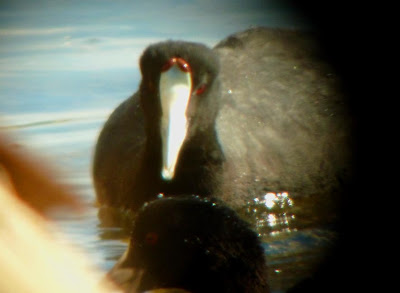
A Red-knobbed Coot (Fulica cristata) in "Ludo", Parque Natural da Ria Formosa, near Faro today (14-02-2012). The bird had been discovered by Joost Falkenburg earlier this winter. Not the first time this species shows up in the area, but not easy to detect them among all the Common Coots (Fulica atra). These birds can be best found by the blue-grey hue of the bill (instead of the pinkish hue on Common Coot). Also the black feathering in front of the eye extends less towards the bill, than on the commoner species, where it forms a black "spike" towards the bill (rounded and less pointed there on Red-knobbed Coot). The red "bulbs" on this one here are comparatively small and easy to overlook - I suppose it is a "first winter". The lower/flat back and the often "fluffy" rump, might also be a hint to spot these rare birds among the hundreds of Coots. Only about 200-300 pairs nest in Europe, most of them in Andalusia, southern Spain. Last year, two pairs nested in the Alentejo-region in South Portugal, one of them on a small pool, in a mixed pair with a Common Coot, which produced one (hybrid) offspring. Some birds origin from the Doñana-National Park in Andalusia have been marked with a white plastic neck-colar, with a code. But not all Coots marked like this are "cristata", since also the Common ones get a neck-ring when trapped in the procedure...
Sunday, February 12, 2012
Color-ringed Spoonbill
Eurasian Spoonbill (Platalea leucorodia) feeding in a tidal channel of the Ria Formosa Natural Park near Faro, Algarve, Portugal on the 11th of February 2012.
The bird has been colour-ringed as a nestling in north Germany (Mellum, Niedersachsen) in June 2011 by Olaf Geiter, with whom I catched and ringed Canada Geese (Branta canadensis) near Cologne in 2003 for his dissertation about Neozoa. Its a small world...
I have been reporting ringed Spoonbills, Flamingos, Gulls, Waders and other aquatic birds here in the Algarve for over 10 years now. The birds life-historys reveal that many Individuals keep coming back, not only to the Algarve every winter, but even to the same lagoon or feeding at the same section of a tidal channel for years and years. In case of the Spoonbills, a species that has extended their breeding distribution northwards along the west coast of Europe, many birds wintering here come from the Netherlands or Germany. If you see or (better) photograph color-ringed Spoonbills, it is appreciated if you sent this observation with all the necessary details to the coordinator of the European ringing-projects of the species, Otto Overdijk, e-mail: o.overdijk AT natuurmonumenten.nl
Friday, February 10, 2012
A rare winter guest

This male Snow Bunting (Plectrophenax nivalis) was filmed at the beach of Vila Real do St. Antonio (Algarve) on the 08/02/2012. It was feeding together with a female in the zone, where the beach meets the pre-dunes, right next to the river-mouth of the Guadiana and pretty confident.
Originally three birds had been discovered at the site in December already. The species nests in the tundra-zone from north Scandinavia on northwards and eastwards and is normally rather a rare winter visitor to Portugal's west coast.
You may want to click on the YouTube-symbol in the right lower corner of the video, to watch it in a larger format and listen to calls at around 0:38
Interesting was also the observation of at least 13 Little Terns (Sterna albifrons) at this time of the year, foraging in the mixing waters of the Guadiana river-mouth. The species is actually strictly an Africa-migrant, but here, some stay during all winter. Possibly the only place in all Europe.
Both, Razorbill (Alca torda) and Great Skua (Stercorarius skua) could be seen entering the river, too.
We found Slender-billed Gulls (Larus genei) in Tavira (in the saltpans on the way to Hotel Vila Galé Albacora) as well as in the saltpans near Fuseta (3 Individuals at each site) the same day, as well as a Black-winged Kite (Elanus caeruleus) perched next to an orchard at the N 125 near Luz de Tavira at the end of the day.
A Crested Coot (Fulica cristata) was yesterday still present here in "Ludo" (Faro-area) just east of the so called "São Lourenço-bridge".
Friday, January 27, 2012
At the cape of São Vicente

At Europe's south-western tip, the shear sea-cliffs form, what is known at the Algarve's best known seawatching spot. Northern Gannet, Great Skua, Balearic- and Manx Shearwater, Razorbill, Shag, Mediterranean Gull and Sandwich Tern are among the most common seabirds seen on a winter day here.
(Foto: GS, Vila do Bispo, 09.12.2011)

One of at least six Alpine Accentors (Prunella collaris) present near the lighthouse. (Foto: Georg Schreier, Vila do Bispo, 09.12.2011). The species is a winter visitor.
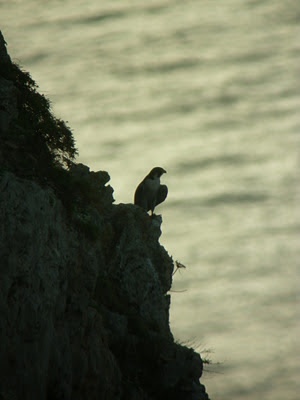
Several pairs of Peregrine nest along the rocky coast.
(Foto: GS, Vila do Bispo, 09.12.2011)

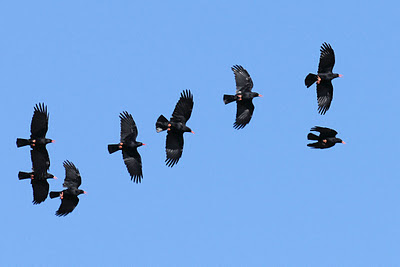
Red-billed Chough (Phyrrhocorax phyrrhocorax) near the cape (Photo: David Rayner). This photo was on the cover of the "Algarve Goodlife Magazine" this last autumn. Some background information about the distribution of the species and the population trend in Europe is here.
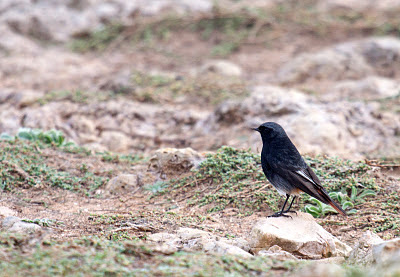
Adult male Black Redstart of the Iberian subspecies "aterrimus" (Photo: Gaby Dienst, Vila do Bispo, 09.12.2011). A widespread resident in the area.

A male Hen Harrier (Circus cyaneus) hunting in the mix of fields and Garigue of the hinterland of the cape (Photo: Gaby Dienst, Vila do Bispo, 09.12.2011). Here, rarities such as Rose-coloured Starling, Pallid Harrier (both juveniles) and Richard's Pipit have been observed by me and others this last autumn.
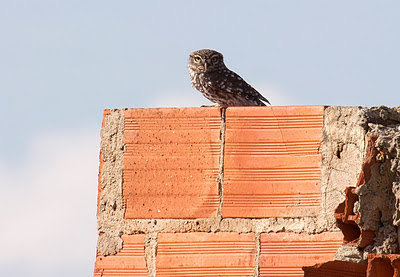
Little Owls are always fascinating... (Photo: Gaby Dienst, Vila do Bispo, 12.09.2011)
Subscribe to:
Posts (Atom)






